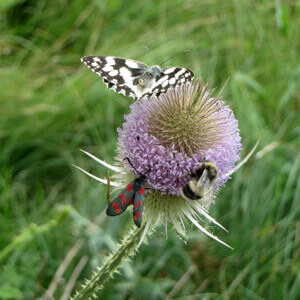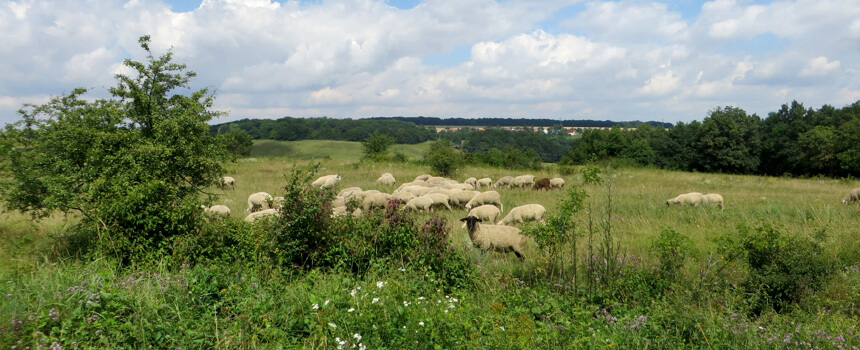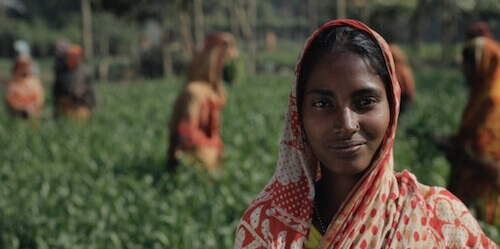 Of pale clouded yellows and lesser purple emperors
Of pale clouded yellows and lesser purple emperors
Blooming meadows for endangered butterflies
How long has it been since you have last seen a pale clouded yellow butterfly flitter across a meadow? Or a lesser purple emperor with its bluely shimmering wings? The number of butterflies has declined massively in the last 30 years. Studies suggest a decline of up to 75 per cent. (Hallmann et al., 2017) And this is already having an impact on birdlife: Many birds, such as swallows or swifts need insects to survive. A wide variety small birds rely on insects especially while rearing their young. But also our own nutrition is heavily reliant on insects: 91 of the 107 most commonly cultivated crops are pollinated by insects to a more or lesser degree. Strawberries, cherries or rape seed produce the highest yields when they are pollinated by wild bees or other insects.
Necessity
Meadows rich in flowers and herbs for the protection of endangered butterflies and other insects.
Activity
The NABU Foundation purchases the Windknollen meadows and thus guarantees the continued grazing by a local shepherd which is needed to preserve them.
Countable effort
Number of square metres that are bought and conserved in the long term.
Result
The shepherd can continue to graze the land and the biodiversity at the Windknollen is actively protected.
Systemic effect
Protection of the Windknollen is maintained in the long term and biodiversity is protected.
Background
In order to preserve the special biodiversity of the Windknollen, a continuation of grazing is necessary. In order to guarantee this in the long term, the NABU Foundation National Natural Heritage has negotiated the purchase of the 195 hectares at the Windknollen with the previous owner, the State Development Corporation of Thuringia. Today’s good deed helps the foundation to purchase part of the area and put it under nature protection status.
Until 2021, the NABU Foundation will purchase this natural paradise. As the owner, the foundation can secure the grazing of the traditional shepherd in the long term and thus preserve the special biodiversity of the Windknollen. This will protect another piece of land that is home to a number of endangered species.
The good deed
The main reason for the loss of biodiversity among insects such as butterflies and bees is the constant intensification of agriculture and of pesticide use, overfertilisation, drainage of wet meadows and the conversion of grassland to arable land. Even in nature reserves, conventional agriculture with all its problems of pesticide use and excessive fertilisation is generally permitted. Often there is also a lack of proper management to preserve the long-term diversity of flora and fauna. Without grazing, species-rich meadows become overgrown – sensitive plants and numerous insects are suppressed in favour of just a few species. The Thuringian nature reserve of Windknollen is threatened by precisely this phenomenon. A very high species diversity has been preserved here, as no pesticides or artificial fertilisers have been used so far. Instead, a flock of sheep has regularly grazed the wide, species-rich semi-arid grasslands over which butterflies such as the pale clouded yellow, the greater and lesser purple emperor or the Adonis blue have been fluttering. Now 195 hectares of this nature reserve are for sale by the previous owner, the State Development Corporation of Thuringia. If a new owner were to terminate the cooperation with the local shepherd, this would be the end of the immense biodiversity and the meadows would overgrown within a few years.

AboutGermany
Berlin
Capital
82 521 653
Number of inhabitants
46.136
Gross domestic product per capita per year
5
Human Development Index
Germany is very densely populated. Much of the land is being used for agriculture. Studies show that even within nature reserves, biodiversity has decreased by 76% since 1990 (Hallmann et al., 2017).
About the organization and further information
Association
NABU-Stiftung Nationales Naturerbe
Website
Initiative Transparente Zivilgesellschaft
Further information and source
- Hallmann et al, 2017. More than 75 percent decline over 27 years in total flying insect biomass in protected areas. PLoS ONE 12(10): e0185809.
- NABU, 2013. Gefährdung und Schutz. Vögel der Agrarlandschaften, Berlin
- Anna Gamero et al., 2016. Tracking Progress Toward EU Biodiversity Strategy Targets, in: Conservation Letters, 10/4, S. 395-402.
- Schöpwinkel, 2017. Metastudie (Literaturauswertung) zum Rückgang der Schmetterlinge (Tagfalter) in Deutschland (speziell Nordrhein-Westfalen)
- Schöpwinkel, 2017. Metastudie (Literaturauswertung) zum Rückgang der Schmetterlinge (Tagfalter) in Deutschland (speziell Nordrhein-Westfalen)
- Anna Gamero et al., 2016. Tracking Progress Toward EU Biodiversity Strategy Targets, in: Conservation Letters, 10/4, S. 395-402.
- NABU, 2013. Gefährdung und Schutz. Vögel der Agrarlandschaften, Berlin
- Hallmann et al, 2017. More than 75 percent decline over 27 years in total flying insect biomass in protected areas. PLoS ONE 12(10): e0185809.




